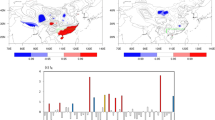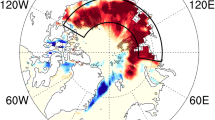Abstract
By using the 160 stations monthly precipitation data and NOAA-ESRL reanalysis data, the effect of spring Antarctic Oscillation (AAO) on Summer Precipitation in North China (SPNC) is studied. The analysis results show that the positive phase of March AAO leads the easterly-southerly and ascend anomalies in the southern part of North China by affecting zonal wind, and meridional circulation in the Northern Hemisphere (NH) late summer, results in more SPNC. Key regions of Antarctic sea-ice may store preceding March AAO signal which is cross-seasonal sustained by the heat exchanging with underlying surface, and the Summer Antarctic Sea-ice Index (SSI) is defined. The upward and poleward propagations of the planetary wave are enhanced in the Southern Hemisphere (SH) high latitude, and there are significant anomalous variabilities of PSI over SH low latitude, high latitude and polar regions in the high SSI years and vice versa. The wave-current interaction weakens the descending motion over the Antarctic, strengthens the circumpolar westerlies and deepens the SH polar vortex (AAO positive phase) in the high SSI years and vice versa. The results of observation and CAM5 show that SSI is positively correlated with indices of Quasi-Biennial Oscillation (QBOI). In QBO westerly phase, the SPNC anomaly in the high SSI years shows out of phase with that in the low SSI years. In the low SSI years, Rossby wave has the characteristics of anomalous southward propagation which corresponds to the abnormal weakening of ascend motion (the decrease of precipitation) over North China. Accompanied with a significant PSI anomaly, there exists a region of weak to strong wave energy over North China which is regarded as the source region of wave energy in both high and low SSI years of QBO westerly phase. But in QBO easterly phase, SPNC anomaly is not significant. QBO may be a bridge that connecting the signals of zonal wind anomalies in the stratosphere of the SH and the NH.

















Similar content being viewed by others
Change history
23 January 2020
The original version of this article unfortunately contains some mistakes.
References
Amita, P., Pramod, M., Rambhau, K., Sanjay, B.: Connection between Antarctic Sea-ice extent and indian summer monsoon rainfall. Int. J. Remote Sens. 30(13), 3485–3494 (2009). https://doi.org/10.1080/01431160802562248
Baldwin, M.P., Gray, L.J., Dunkerton, T.J., Hamilton, K., Haynes, P.H., Randel, W.J., et al.: The quasi-biennial oscillation. Rev. Geophys. 39(2), 179–229 (2001). https://doi.org/10.1029/1999rg000073
Bian, L., Lin, X.: Antarctica Sea-ice oscillation and its possible impact on monsoon of south sea and China summer rainfall. J. Glaciol. Geocryol. 30(2), 196–203 (2008). https://doi.org/10.3724/SP.J.1047.2008.00014 (In Chinese)
Bian, L., Lin, X., Xia, L.: Antarctica Sea-ice oscillation and its possible impact on monsoon of south sea. Chinese Journal of Polar Science. 21(1), 11–21 (2010). https://doi.org/10.3724/SP.J.1085.2010.00011
Bintanja, R., Selten, F.M.: Future increases in arctic precipitation linked to local evaporation and sea-ice retreat. Nature. 509(7501), 479–482 (2014). https://doi.org/10.1038/nature13259
Choi, K.S., Oh, S.B., Kim, D.W., Byun, H.R.: Possible influence of AAO on north Korean rainfall in august. Int. J. Climatol. 34(6), 1785–1797 (2014). https://doi.org/10.1002/joc.3801
Coy, L., Newman, P.A., Pawson, S., Lait, L.R.: Dynamics of the disrupted 2015-16 quasi-biennial oscillation. J. Clim. (2017). https://doi.org/10.1175/JCLI-D-16-0663.1
Fan, K., Wang, H.: Antarctic oscillation and the dust weather frequency in North China. Geophys. Res. Lett. 31(10), 399–420 (2004). https://doi.org/10.1029/2004gl019465
Fan, K.: Atmospheric circulation in southern hemisphere and summer rainfall over Yangtze river valley. Chin. J. Geophys. 49(3), 599–606 (2006). https://doi.org/10.1002/cjg2.873
Fan, K., Wang, H.: Interannual variability of Antarctic oscillation and its influence on east Asian climate during boreal winter and spring. Science in China. 49(5), 554–560 (2006). https://doi.org/10.1007/s11430-006-0554-7
Fan, K., Wang, H.: Simulation of the AAO anomaly and its influence on the northern hemispheric circulation in boreal winter and spring. Chin. J. Geophys. 50(50), 376–382 (2007). https://doi.org/10.1002/cjg2.1045
Gao, H., Xue, F., Wang, H.: Interannual variation of Antarctic oscillation and its impact on Meiyu over the Yangtze-Huaihe River and its forecasting significance. Chin. Sci. Bull. 48(z1), 87–92 (2003). https://doi.org/10.3321/j.issn:0023-074X.2003.z1.016
Holton, J., Tan, H.: The influence of the equatorial quasi-biennial oscillation on the global circulation at 50mb. J. Atmos. Sci. 37(10), 2200–2208 (1980). https://doi.org/10.1175/1520-0469(1980)037<2200:TIOTEQ>2.0.CO;2
Huang, R.H. & Li, W.J.: Influence of the heat source anomaly over the tropical western Pacific on the subtropical high over East Asia. Proc. International Conference on the General Circulation of East Asia. 40–51 (1987)
Ho, C.H., Kim, J.H., Kim, H.S., Sui, C.H., Gong, D.Y.: Possible influence of the Antarctic oscillation on tropical cyclone activity in the western north pacific. J. Geophys. Res.-Atmos. 110(D19), (2005). https://doi.org/10.1029/2005JD005766
Hsu, H.H., Lin, S.M.: Asymmetry of the tripole rainfall pattern during the east Asian summer. J. Clim. 20(17), 4443–4458 (2007). https://doi.org/10.1175/JCLI4246.1
Ho, C.H., Kim, H.S., Jeong, J.H., Son, S.W.: Influence of stratospheric quasi-biennial oscillation on tropical cyclone tracks in western north pacific. Geophys. Res. Lett. 36(6), 141–153 (2009). https://doi.org/10.1029/2009GL037163
Hu, C., Wu, Q., Yang, S., Yao, Y., Chan, D., Li, Z., Deng, K.: A linkage observed between austral autumn Antarctic oscillation and preceding Southern Ocean SST anomalies. J. Clim. 29(6), 2109–2122 (2016). https://doi.org/10.1175/JCLI-D-15-0403.1
He, S., Gao, Y., Furevik, T., Wang, H., Li, F.: Teleconnection between sea ice in the Barents Sea in June and the silk road. Pacific-Japan and East Asian rainfall patterns in August. ADV ATMOS SCI. 35(1), 52–64 (2018). https://doi.org/10.1007/s00376-017-7029-y
Li, Z., Ma, S.: Relationship between the phase of 50 hPa QBO in summer season and the precipitation in the south of North China. Meteorological Monthly. 18(9), 3–7 (1992). https://doi.org/10.7519/j.issn.1000-0526.1992.9.001 (In Chinese)
Lin, A., De-Jun, G., Bin, Z., Chun-Hui, L., Zhong-Ping, J.: Relationship between South China Sea summer monsoon onset and Southern Ocean sea surface temperature variation. Chin. J. Geophys. 56(2), 383–391 (2013). https://doi.org/10.6038/cjg20130203
Liu, T., Li, J., Zheng, F.: Influence of the boreal autumn southern annular mode on winter precipitation over land in the northern hemisphere. J. Clim. 28(22), (2014). https://doi.org/10.1175/JCLI-D-14-00704.1
Li, Y., Guo, P.: Characteristics and mechanisms of unimodal and bimodal precipitation processes in North China in summer. Trans. Atmos. Sci. 38(4), 540–548 (2015). https://doi.org/10.13878/j.cnki.dqkxxb.20140918001
Nitta, T.: Convective activities in the tropical Western Pacific and their impact on the northern hemisphere summer circulation. J. Meteorol. Soc. Jpn. 65, (1987). https://doi.org/10.2151/jmsj1965.65.3_373
Plumb, R.: On the three-dimensional propagation of stationary waves. J. Atmos. Sci. 42(3), 217–229 (1985). https://doi.org/10.1175/1520-0469(1985)042<0217:OTTDPO>2.0.CO;2
Qin, J., Wang, P., Ye, M., Cui, C.: Impacts of February Antarctic oscillations on summer precipitation in eastern China. Acta Meteorologica Sinica. 18(3), 363–368 (2004) (In Chinese)
Qin, J., Wang, P.X., Gong, Y.: Impacts of Antarctic oscillation on summer moisture transport and precipitation in eastern China. Chin. Geogr. Sci. 15(1), 22–28 (2005). https://doi.org/10.1007/s11769-003-0064-x
Silvestri, Gabriel, E.: Antarctic oscillation signal on precipitation anomalies over southeastern South America. Geophys. Res. Lett. 30(21), 2115 (2003). https://doi.org/10.1029/2003gl018277
Screen, J.A.: Influence of arctic sea ice on European summer precipitation. Environ. Res. Lett. 8(4), 4015 (2013). https://doi.org/10.1088/1748-9326/8/4/044015
Song, F., Zhou, T.: Interannual variability of east Asian summer monsoon simulated by CMIP3 and CMIP5 AGCMS: skill dependence on Indian ocean–western pacific anticyclone teleconnection. J. Clim. 27(4), 1679–1697 (2014). https://doi.org/10.1175/JCLI-D-13-00248.1
Song, J., Zhou, W., Li, C., Qi, L.: Signature of the Antarctic oscillation in the northern hemisphere. Meteorog. Atmos. Phys. 105(1–2), 55–67 (2009). https://doi.org/10.1007/s00703-009-0036-5
Shao, X., Li, S., Liu, N., Song, J.: The madden–Julian oscillation during the 2016 summer and its possible impact on rainfall in China. Int. J. Climatol. 38(5), (2018). https://doi.org/10.1002/joc.5440
Sun, W., Li, J., Yu, R., Yuan, W.: Circulation structures leading to propagating and non-propagating heavy summer rainfall in central North China. CLIM DYNAM. 7, 1–19 (2018). https://doi.org/10.1007/s00382-018-4090-x
Thompson, D.W.J., Wallace, J.M.: Annular modes in the extratropical circulation. Part I: month-to-month variability*. J. Clim. 13(5), 1000–1016 (2000). https://doi.org/10.1175/1520-0442(2000)013<1000:amitec>2.0.co;2
Tu, K., Yan, Z.W., Dong, W.J.: Climatic jumps in precipitation and extremes in drying North China during 1954-2006. J METEOROL SOC JPN. Ser. II. 88(1), 29–42 (2010). https://doi.org/10.2151/jmsj.2010-103
Tan, G., Chen, H., Sun, Z., Den, W.: Linkage of the cold event in January 2008 over China to the North Atlantic oscillation and stratospheric circulation anomalies. Chin. J. Atmos. Sci. 34(1), 175–183 (2010)
Takaya, K., Nakamura, H.: A formulation of a phase-independent wave-activity flux for stationary and migratory Quasigeostrophic eddies on a zonally varying basic flow. J. Atmos. Sci. 58, 608–627 (2001). https://doi.org/10.1175/1520-0469(2001)058<0608:AFOAPI>2.0.CO;2
Varotsos, C.A., Sarlis, N.V., Efstathiou, M.: On the association between the recent episode of the quasi-biennial oscillation and the strong El Niño event. Theor. Appl. Climatol. (2017). https://doi.org/10.1007/s00704-017-2191-9
Wu, L., Liu, Z., Li, C., Sun, Y.: Extratropical control of recent tropical pacific decadal climate variability: a relay teleconnection. CLIM DYNAM. 28(1), 99–112 (2007). https://doi.org/10.1007/s00382-006-0198-5
Wu, Q.: Associations of diurnal temperature range change with the leading climate variability modes during the northern hemisphere wintertime and their implication on the detection of regional climate trends. J. Geophys. Res.-Atmos. 115(D19), (2010). https://doi.org/10.1029/2010JD014026
Wu, Q., Zhang, X.: Observed evidence of an impact of the Antarctic Sea ice dipole on the Antarctic oscillation. J. Clim. 24(16), 4508–4518 (2011). https://doi.org/10.1175/2011JCLI3965.1
Xue, F., Wang, H., He, J.: Interannual variability of Mascarene high and Australian high and their influences on summer rainfall over East Asia. Chin. Sci. Bull. 48(5), 492–497 (2003). https://doi.org/10.1007/bf03183258
Xu, Z., Qian, Y.: Climatic effects of 100 hPa easterly air flow in tropical (II): its relationship with summer rainfall in North China. Plateau Meteorology. 24(4), 570–576 (2005). https://doi.org/10.1007/s10409-004-0010-x
Xiao, B., Zhang, Y., Yang, X., Nie, Y.: On the role of extratropical air-sea interaction in the persistence of the southern annular mode. Geophys. Res. Lett. 43(16), 8806–8814 (2016). https://doi.org/10.1002/2016GL070255
Yang, S., Deng, K., Ting, M., Hu, C.: Advances in research on atmospheric energy propagation and the interactions between different latitudes. J Meteorol Res. 29, 859–883 (2015). https://doi.org/10.1007/s13351-015-5088-5
Yang, X.Q., Xie, Q., Zhu, Y.M., Sun, X.G., Guo, Y.J.: Decadal-to-interdecadal variability of precipitation in North China and associated atmospheric and oceanic anomaly patterns. Chin. J. Geophys. 48(4), 789–797 (2005). https://doi.org/10.1111/j.1745-7254.2005.00209.x
Zhou, T., Yu, R.: Sea-surface temperature induced variability of the southern annular mode in an atmospheric general circulation model. Geophys. Res. Lett. 31(24), L24206 (2004). https://doi.org/10.1029/2004gl021473
Zhang, L., Karnauskas, K.B., Weiss, J.B., Polvani, L.M.: Observational evidence of the downstream impact on tropical rainfall from stratospheric kelvin waves. CLIM DYNAM. (2017). https://doi.org/10.1007/s00382-017-3844-1
Zhao, S., Chen, L., Cui, T.: Effects of ENSO phase-switching on rainy-season precipitation in North China. Chin. J. Atmos. Sci. 41(4), (2017). https://doi.org/10.3878/j.issn.1006-9895.1701.16226
Acknowledgements
This study is supported by the Strategic Priority Research Program of the Chinese Academy of Sciences (Grant NO. XDA19070402).
Author information
Authors and Affiliations
Corresponding author
Additional information
Responsible Editor: Kyong-Hwan Seo.
Publisher’s Note
Springer Nature remains neutral with regard to jurisdictional claims in published maps and institutional affiliations.
Rights and permissions
About this article
Cite this article
Yuan, Z., Qin, J., Li, S. et al. Impact of Spring AAO on Summertime Precipitation in the North China Part: Observational Analysis. Asia-Pacific J Atmos Sci 57, 1–16 (2021). https://doi.org/10.1007/s13143-019-00157-2
Received:
Revised:
Accepted:
Published:
Issue Date:
DOI: https://doi.org/10.1007/s13143-019-00157-2




